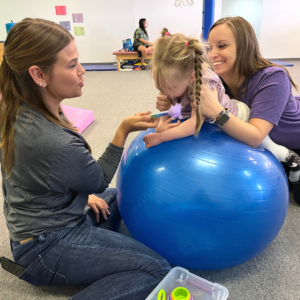My child qualifies for occupational therapy at school; should I stop coming to the clinic?
NO! (Although this may vary based on family circumstances).

A child is able to receive occupational therapy at school and in the clinic at the same time. This can actually be incredibly beneficial for the child, and we highly recommend continuing both services when needed. Clinic and school-based therapy utilize different treatment models to address slightly different areas of need for your child. School based OT’s practice under an educational model using treatment that is directly related to the student’s ability to access their education. Meanwhile, an outpatient OT practices under a medical model addressing areas of function impacting participation across several environments including home and community.
Educational Model of Occupational Therapy
In school, occupational therapists are related service providers supporting educational goals for students which are outlined in an Individualized Education Plan or IEP. A referral can be made by the teacher, or requested by the family. The student is then evaluated by a team of providers including school psychologist, speech therapist, occupational therapist, and physical therapist, when warranted. Once eligibility is determined, the goals are written by the IEP team and agreed upon by the family.
The role of the occupational therapist in this setting is to assess underlying deficits, such as fine motor and visual motor skills, social emotional skills, attention, and regulation, which are impacting the student’s participation at school and their ability to meet the established goals. The occupational therapist will also assess the student’s learning environment and make modifications as needed. An occupational therapist in the school may also provide consultative services, such as under a 504 plan, where they may make recommendations on environmental adaptations or accommodations to improve participation without providing direct ongoing services. School based services are provided at no cost to the family.
Check out this Parent brochure from the American Occupational Therapy Association (AOTA) for more information about school-based services.
Medical Model of Occupational Therapy
In the medical model, a referral is typically made by the child’s pediatrician, but can also be initiated by a parent or other healthcare provider. It is very common for a family to seek out speech therapy or physical therapy first before being referred for occupational therapy. Once the referral is made, the occupational therapist will evaluate the child looking at strengths and areas of need including fine motor and visual motor skills, sensory processing skills, motor coordination, attention, regulation, safety, self-care skills, community involvement, etc. which are affecting participation at home and in the community. This may include school.
An outpatient therapist will work with primary care providers to make appropriate referrals for any required specialists, or additional services. At Kids Place, we provide primarily clinic-based services, but outpatient care can also be carried out at home, in hospitals, or in community-based settings. Outpatient services are paid for by the family, typically through their insurance provider.
It is true that there are several areas of overlap between school and clinic based occupational therapy. It is also true that both are beneficial to the child in different ways, and can address different areas of need. The clinic-based therapist cannot observe a child in the classroom to make specific recommendations. Likewise, a school-based therapist is not going to address self-care skills carried out at bedtime. However, both are important to the overall success and progress of the child.







